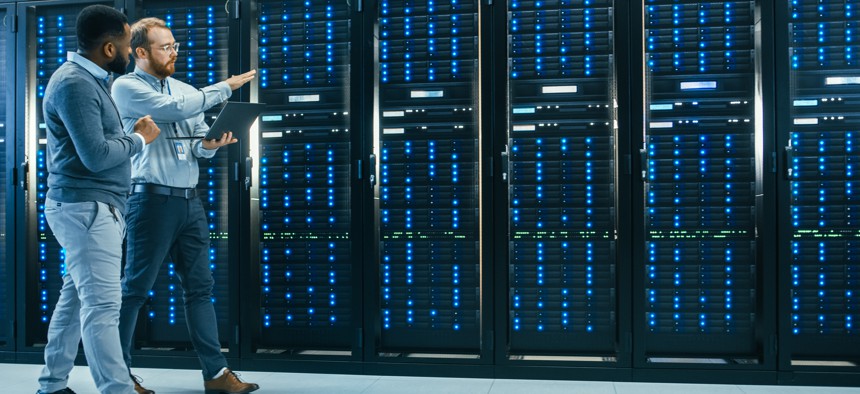sponsor content What's this?
How government leaders can harness the power of innovation on a budget

Presented by
SHI Federal

Next-generation labs are the key to unlocking innovation on a budget.
Technology is constantly evolving. Emerging capabilities like artificial intelligence hold a lot of promise in helping the government deliver on the mission, but pursuing digital transformation can be costly.
Federal IT leaders can mitigate costs while progressing towards a responsible transformation by collaborating with reputable industry leaders. This can be done in the following ways:
- Initiating Concept Proofs and Pilot Programs: Collaboration with industry partners can aid in the creation of concept proofs or pilot programs. This gives them the opportunity to assess the viability and efficiency of new technologies on a smaller, more manageable scale before a broad roll-out.
- Implementation of Testbeds: The development or usage of existing testbeds, which are regulated environments for the safe testing of new technologies, can be beneficial. This approach can help pinpoint potential challenges or hindrances prior to comprehensive deployment.
- Learning from Diverse Solution Providers: There are numerous solution providers who have experience with a variety of public and private organizations and are actively employing innovative technologies like artificial intelligence and machine learning. By learning from these experiences, Federal IT leaders can glean applicable insights for the public sector.
Finding a home for innovation in government
When pursuing digital transformation, government leaders should have a safe space where they can explore interoperability between original equipment manufacturers (OEMs) and their existing technology stack.
Unfortunately, in many innovation labs there’s a distinct focus on membership numbers and canned demonstrations, versus providing agencies with the resources necessary to measure the impact of emerging technologies.
With increasing legislation coming out around the need to reduce unnecessary costs, some industry leaders, like Tim Henning, director of presales engineering for SHI Federal, are looking to reinvent the lab.
“At SHI Labs’ Customer Innovation Center (CIC), we try to customize everything so that it really focuses on what the customer need is,” Henning said. “We focus on exactly what that customer wants to see instead of doing something generic.”
Exploring new capabilities and measuring the impact of emerging technology on an agency’s tech stack is at the heart of many next-generation labs. Instead of selling leaders on a specific product or capability, teams collaborate to solve an issue, all while keeping in mind an agency’s specific requirements and budgetary constraints.
As teams collaborate to assess the viability and efficiency of new technologies, industry leaders within these labs are well versed in the mundane aspects of digital transformation that often don’t come up until an issue arises. For example, how easy was it to acquire a specific part from an original equipment manufacturer? Or how easy was it to install the software update?
Next-generation innovation labs provide leaders with a holistic, real world experience where government leaders can explore “full OEM interoperability” versus a less customized experience that they may find in other innovation centers.
“That’s huge,” said Joe Krakoski, director of federal contract capture and development at SHI Federal. “That way when it gets into the customer’s environment, they know it works and it performs and has the feature functionality in a mature state to scale in large government environments.”
Driving responsible digital transformation
Digital transformation is crucial to achieving some of the government’s key goals and objectives. By leveraging digital technologies and tools, government agencies could optimize their operations, increase efficiency and enhance service delivery to the end-user.
PEO EIS is looking to harness this power to build platforms to better serve the warfighter at the mission’s edge through its second iteration of the Army Data Platform. In order to do so, leadership are actively looking for solutions that are able to integrate with existing technology.
This is where a true IT integrator can support the federal government. In vendor agnostic labs, leaders can work alongside subject matter experts to explore the art of the possible and understand how a certain technology or capability will impact the organization. By embracing next-generation labs, government agencies can solve common issues, build out concept proofs and validate plans brought to fruition by systems integrators.
If systems integrators are the policy and planning experts at the top of the development funnel, IT integrators are the “boots on the ground” helping government agencies test out technologies and streamline deployment.
The next-generation lab is a valuable proving ground for exploring interoperability between OEMs and software developers, as these locations provide a controlled environment in which emerging technologies can be tested and evaluated before deploying to an agency’s network. And by working together, the federal government can effectively harness the power of innovation on a budget.
“You don’t want to stop innovating,” Henning said. “You need to rely on someone that can give you that agnostic approach, that can cover the different solutions and cover the new technology that is coming out.”
About SHI Federal
SHI Federal provides modern IT solutions for a proactive federal government. As the largest Minority/Woman Owned Business Enterprise (MWBE) in the U.S., we engage in strategic procurement partnerships to enable your federal agency to meet its organizational goals.
We encourage you to connect with the experts at SHI Federal to learn more about the customer innovation center and how it can help your agency.
This content is made possible by our sponsor, SHI Federal. The editorial staff of NextGov/FCW was not involved in its preparation.
NEXT STORY: The New (Cyber) Administration





